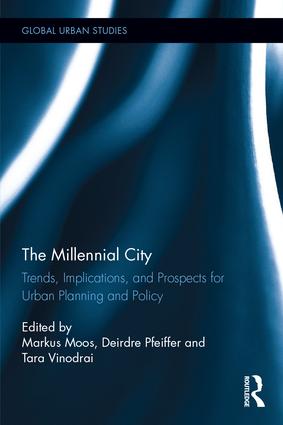
The Millennial City: Trends, Implications, and Prospects for Urban Planning and Policy
Markus Moos, Deirdre Pfeiffer, Tara Vinodrai
Millennials have captured our imaginaries in recent years. The conventional wisdom is that this generation of young adults lives in downtown neighbourhoods near cafes, public transit and other amenities. Yet, this depiction is rarely unpacked nor problematized. Despite some commonalities, the Millennial generation is highly diverse and many face housing affordability and labour market constraints. Regardless, as the largest generation following the post-World War II baby boom, Millennials will surely leave their mark on cities.
This book assesses the impact of Millennials on cities. It asks how the Millennial generation differs from previous generations in terms of their labour market experiences, housing outcomes, transportation decisions, the opportunities available to them, and the constraints they face. It also explores the urban planning and public policy implications that arise from these generational shifts.
This book offers a generational lens that faculty, students and other readers with interest in the fields of urban studies, planning, geography, economic development, demography, or sociology will find useful in interpreting contemporary U.S. and Canadian cities. It also provides guidance to planners and policymakers on how to think about Millennials in their work and make decisions that will allow all generations to thrive.
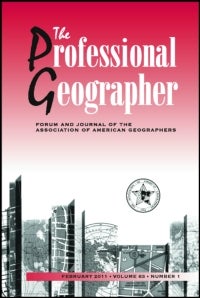
Pathways and Processes: Reviewing the Role of Young Adults in Urban Structure
Nick Revington
Challenges arising from changing demographics, expensive housing, and precarious labor have prompted recent interest in the residential geographies of young adults. Yet, despite attention to young adults' diverse housing pathways, I argue that greater focus is needed on the place-based and spatial underpinnings and effects of particular housing pathways: Connections to urban processes of “youthification”—the concentration of young adults in dense neighborhoods—and “studentification”—whereby an area becomes dominated by university students—remain underdeveloped, as do linkages between these phenomena and gentrification. I explore these connections through a critical review of extant literature to show that the enactment of some pathways is associated with particular urban processes, which might foreclose certain pathways for other individuals. Finally, I identify three crucial areas of inquiry: (1) how youthification, studentification, and gentrification interact; (2) how these processes shape and are shaped by diverging individual housing pathways; and (3) how differences among young adults such as race, ethnicity, and gender intersect with age in the course of these processes.
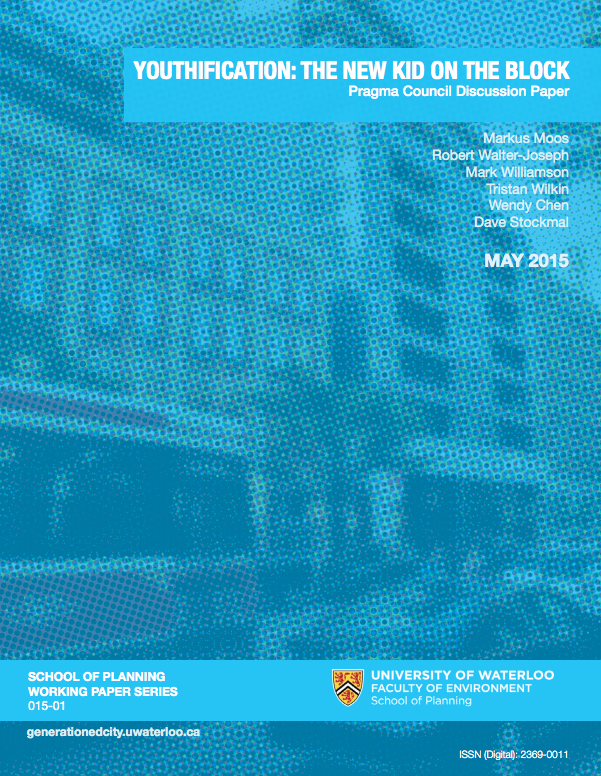
Youthification: The New Kid on the Block (.pdf)
Markus Moos et al.
The purpose of this report is to summarize the state of the literature on the factors that brought about changes in young adults’ residential location patterns. The report outlines the various explanations for the increasing concentration of young adults in central areas, dubbed “youthification”. It points to housing market and regulatory changes as well as demographic and broader macro economic transitions that have contributed to increases in inner city redevelopment and intensification.
It is important for planners and the development community to consider the factors that are bringing about changes in young adults’ residential location patterns, as it will help in planning for future housing demand and transportation patterns. The information will also help anticipate potential affordability concerns and shed light on the age composition of neighbourhoods. Increasing segregation of age groups has potential impact on social cohesion, which falls within the domain of social planners...
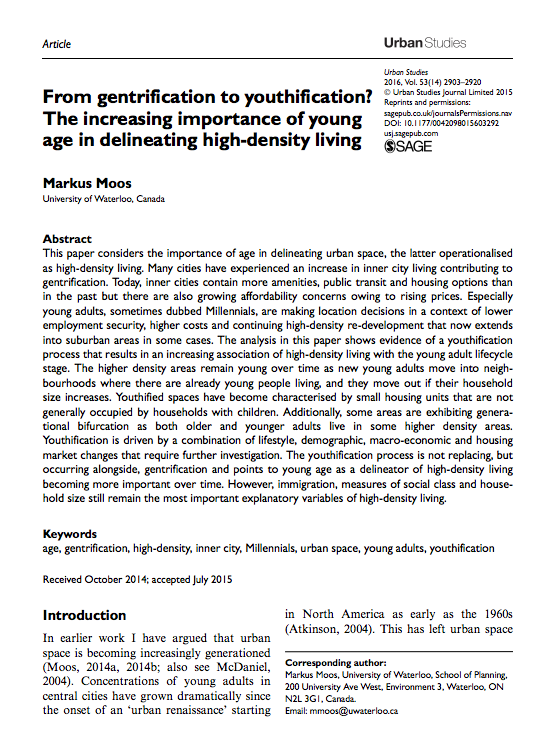
Markus Moos
This paper considers the importance of age in delineating urban space, the latter operationalised as high-density living. Many cities have experienced an increase in inner city living contributing to gentrification. Today, inner cities contain more amenities, public transit and housing options than in the past but there are also growing affordability concerns owing to rising prices. Especially young adults, sometimes dubbed Millennials, are making location decisions in a context of lower employment security, higher costs and continuing high-density re-development that now extends into suburban areas in some cases. The analysis in this paper shows evidence of a youthification process that results in an increasing association of high-density living with the young adult lifecycle stage. The higher density areas remain young over time as new young adults move into neighbourhoods where there are already young people living, and they move out if their household size increases. Youthified spaces have become characterised by small housing units that are not generally occupied by households with children. Additionally, some areas are exhibiting generational bifurcation as both older and younger adults live in some higher density areas. Youthification is driven by a combination of lifestyle, demographic, macro-economic and housing market changes that require further investigation. The youthification process is not replacing, but occurring alongside, gentrification and points to young age as a delineator of high-density living becoming more important over time. However, immigration, measures of social class and household size still remain the most important explanatory variables of high-density living.
Telling Stories: An intergenerational dialogue on housing (.pdf)
This dialogue brought together secondary school students, university students and seniors to foster inter-generational dialogue. Panellists’ comments helped shed insight into how our past experiences shape the types of housing and neighborhoods we see as desirable later in life.
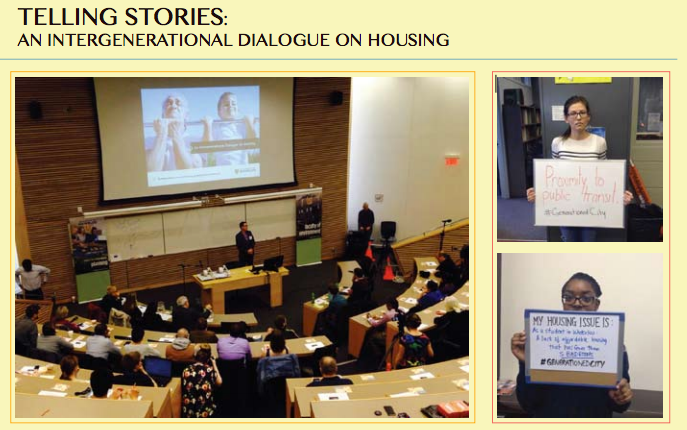
Articles and book chapters
- Moos, M. and Woodside, J. (2017) Sustainability as an urban way of living: The uneven outcomes of “sustainable mobility infrastructure” planning. In Pierre Filion (Ed.) Global Suburban Infrastructures. Toronto: University of Toronto Press.
- Moos, M. (2015) How city planning can cause greater generational divides. Huffington Post, Politics, Canada. http://www.huffingtonpost.ca/markus-moos/
- Moos, M. (2015) Generational change and the city: How age defines the urban landscape. In P. Filion, M. Moos, T. Vinodrai and R. Walker (Eds.). Canadian Cities in Transition: Perspectives for an Urban Age (Fifth Edition). (pp. 343-363). Don Mills, Ontario: Oxford University Press.
- Moos, M., Wilkin, T., Seasons, M. and Chase, G. (2015) Planning for housing in a time of growing employment precarity. Plan Canada. Spring, 12-17.
- Moos, M., Williams, M., Agarwal, A. (2015). Millenials ditching their cars: For now or for good? Curb Magazine, 5(3), 24-25.
- Moos, M. (2014) “Generationed” space: Societal restructuring and young adults’ changing location patterns. The Canadian Geographer, 58(1), 11-33.
- Moos, M. (2014) Generational Dimensions of Neoliberal and Post-Fordist Restructuring: The Changing Characteristics of Young Adults and Growing Income Inequality in Montreal and Vancouver. International Journal of Urban and Regional Research. 38(6), 2078-2102.
- Moos, M. (2014) A city divided by age? Generational shifts in urban development. Our Schools, Our Selves: The Canadian Centre for Policy Alternatives, 23(3), 101-106.
Conference papers
- Moos, M. (2016) Paper presentation: Generationing Housing: The role of intergenerational wealth transfer in young adults’ housing outcomes. Association of Collegiate Schools of Planning conference, Portland, Oregon, November 3 – 6.
- Moos, M., Prayitno, N. and Revington, N. (2016) Paper presentation: I drive to work, sometimes: Motility capital and mode flexibility among young adult gentrifiers. Association of Collegiate Schools of Planning conference, Portland, Oregon, November 3 – 6.
- Henry, J. and Moos, M. (2016) Paper presentation: An index of generational congestion: Measuring the rise and fall surrounding “peak millennial” in mid-sized and large metropolitan areas in the United States and Canada. Association of Collegiate Schools of Planning conference, Portland, Oregon, November 3 – 6.
- Moos, M. Revington, N., Wilkin, T. and Andrey, J. (2016) The structure of the “knowledge economy” city: The location of post-secondary institutions and the intersections among gentrification, studentification and youthification. Association of Collegiate Schools of Planning conference, Portland, Oregon, November 3 – 6.
- Revington, N., Prayitno, K. and Moos, M. (2016) Beyond housing: Concurrent pathways in young adults' lives. Annual Meeting of the Association of American Geographers, San Francisco, California, April 1.
- Moos, M. (2015) Paper presentation: Will Millennials Remain In The City? Residential Mobility In Post-Industrial, Post-Modern, Post-Suburban America. Association of Collegiate School of Planning Conference, Houston, Texas, October 22 – 25.
- Moos, M. (2015) Paper presentation: Sustainability as an urban way of living: The equity implications of planning policies. Global Suburbanisms Infrastructure Workshop. University of Waterloo, School of Planning.
- Moos, M. (2015) Paper presentation: New dimensions of exclusion: Age, household size and mobility in the 'sustainable' city. Annual Meeting of the Association of American Geographers, Chicago, Illinois, March 29-April 2.
- Moos, M. (2014) Paper presentation: From gentrification to youthification: How inner city redevelopment and the influx of young adults are increasing the importance of age in delineating urban space. Association of Collegiate School of Planning Conference: Big Ideas, Global Impacts, Philadelphia, Pennsylvania, October 30 – November 2.
Invited talks
- Moos, M. (October 1, 2015) Housing the next generation. Edmonton, Alberta, Capital Region Board. Keynote Address.
- Moos, M. (June 4, 2015) Is austerity contributing to the generational divide? Canadian Center for Policy Alternatives, Vancouver, BC.
- Moos, M. (May 7, 2015) Youthification: The new kid on the block? University of Waterloo, School of Planning, Pragma Council conference.
- Moos, M. (March 30, 2015) Young adults and economic development. Thunder Bay Bike Summit, Evening Public Forum, Keynote Address.
- Moos, M. (September 14, 2014) How are Millennials changing our cities? The planning implications of generational change. Public lecture. Simon Fraser University, City Centre, Continuing Studies & Metro Vancouver TransLink.
- Moos, M. (October 10, 2014) From gentrification to youthification: Millennials’ preferences for urban living and the implications for planning. Social Planning Council of Kingston & School of Urban and Regional Planning, Queen’s University.